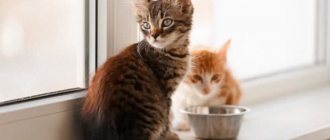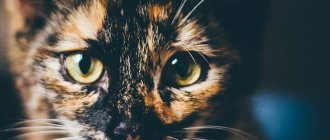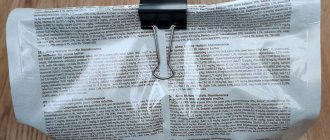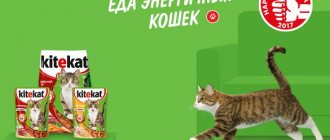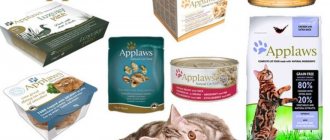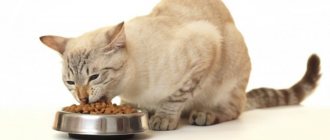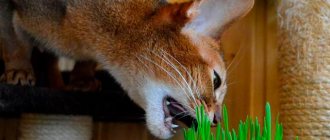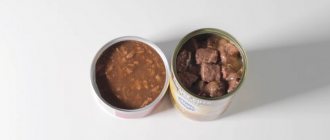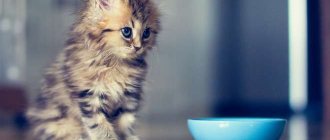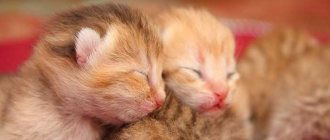The health of pets directly depends on their diet. In addition to poor-quality food, a lack of nutrients or their excess can lead to complications. For this reason, veterinarians recommend measuring the daily portion in grams.
The amount of food per day will vary for cats of different ages and activity levels. When calculating an individual portion, you will need to take into account other important factors affecting metabolism. Otherwise, your pet may suffer from obesity or dystrophy.
How much food to give a cat per day: calculating the daily portion
It is important to note that mixing dry granules and natural products is hazardous to your health. When feeding, you must stick to only one type of food, remembering to follow the recommended dosage.
Dry product
All manufacturers of dry food must place a special table on the packaging indicating how much food a cat needs per day. The calculation takes into account the age and body weight of the animal.
When choosing dry granules, take into account the individual characteristics of your pet. In a pet store you can find lines for certain breeds, pregnant, lactating and sick animals.
For example, let’s take 2 Canadian foods intended for adult cats:
| Brand | Weight, kg) | Daily serving (g) |
| Eukanuba | 2 | 32 |
| 4 | 52 | |
| 6 | 70 | |
| 8 | 93 | |
| 10 | 131 | |
| Now | 2,3-3,2 | 29-40 |
| 3,2-4,2 | 36-58 | |
| 4,5-6 | 52-96 | |
| 6-7,3 | 87-119 |
The difference in recommended volume is due to the size of the granules and their calorie content, and Now also takes into account physical activity. Because of this, focusing on some kind of average is completely pointless.
Pate or spiders
Meat pates and pouches are given in addition to dry granules or separately. The latter option is suitable for cats with dental or gastrointestinal problems.
When calculating the daily dose of wet food, as well as dry food, you should follow the instructions on the packaging. The consumption here is higher, since, unlike granules, dehydration is not used in their production. For 1 g of cat crackers there is at least 2.5 g of pate and 4.5 g of spider meat pieces.
If we carry out the calculation using Eucanuba as an example, then a 6-kilogram cat will need 175 g of pate, or 315 g of meat pieces per day. Please note that these data assume monofeeding of wet food only. When combined with granules, the dosage will be half as much.
Natural food
With natural food everything is much more complicated. Here you will have to take into account not only grams, but also the amount of proteins, fats and carbohydrates. Their percentage should correspond to the following proportion - 52:36:12.
The majority should be products of animal origin (meat, offal, fish, eggs, dairy products), and the smaller portion should be products of plant origin (cereals, vegetables, fruits).
The daily portion should be about 5% of the cat's body weight. If your pet weighs 4 kg, then it is recommended that he eat 200 g of natural food.
Despite its simplicity and convenience, this formula does not take into account a number of important factors. For this reason, it is much more reliable to calculate not grams, but the total calorie content - 90 calories per 1 kg of animal weight.
Which dry food is better
When choosing food, it is very important to pay attention to all components. Thus, manufacturers practice using bone meal, protein extract or meat by-products in the recipe. Paws, intestines, necks, bones, small feathers, and underdeveloped eggs are added to poultry products. Meat products use pork and beef by-products: cartilage, joints, parts of limbs, and blood vessels. According to experts, these elements are not very well absorbed, although they contain meat.
There are several opinions regarding the presence of offal:
- in nature, cats eat prey as a whole, so the inclusion of various components is quite acceptable;
- preference should be given to feed that does not contain by-products of questionable quality;
- It is recommended to purchase granules containing natural ingredients.
An excellent option would be grain-free nutritional formulas, which have a higher price. If they contain plant components, the best option would be oats and rice, which are less likely to contribute to the occurrence of allergic reactions. You should not buy food with the addition of corn, barley, soy, or wheat.
High carbohydrate content contributes to obesity and other health problems. Cats are carnivores, so their bodies do not absorb these components well.
Which dry food is better
How many calories do you need per day
The total calorie content is calculated using the following formula: K*(30*m + 70), where K is the multiplier coefficient, and m is the body weight of the animal. And if everything is clear with indicator 2, then the required coefficient value can be found in the table below.
| Physiological features | K |
| Obesity diagnosed by a veterinarian | 0,8 |
| Tendency to overeat, fraught with rapid obesity | 1 |
| Elderly age | 1,1 |
| Spayed and neutered animals | 1,2 |
| Kitten or adult pets with a small body weight | 1,2-1,4 |
| Inactive adult cat | 1,4 |
| Active adult cat | 1,6 |
| Gestation period for kittens | 1,6-2 |
| Breastfeeding period | 2-4 |
If your pet weighs 5.5 kg, constantly begs and eats everything that is not nailed down, and his furry body can hardly fit into his own house, then he will need 235 kcal per day. Please note that this is not a single portion, but a daily one. It will need to be divided by the number of feedings (usually 2).
Another example is the chicken-flavored Eukanuba. The calorie content of the granules is 4000 kcal per 1 kg, and the weight of the pack is 2 kg. That is, our hypothetical cat will have enough of this pack for 34 days (4000 kcal * 2 kg/235 kcal).
The required number of grams can be found by dividing 2 kg by 34 meals received previously. When rounded, the result is 59 g, and this figure actually fits into the standards specified by the manufacturer.
The norm depends on the weight of the cat
To determine the amount of dry food for a cat, the first thing you have to do is weigh it. To do this, you can use ordinary household scales: you need to stand on them with your pet, and then without him, and calculate the difference. In a similar way, a cat is weighed in a cat house or plastic box, and then the tare weight is taken away.
Now you need to determine whether the result obtained is normal, or whether the cat is already obese. When the weight does not exceed 5 kg, there is definitely nothing to worry about. If you get more, don’t rush to put your cat on a diet either: for representatives of large breeds, it is quite acceptable to weigh 6–9 kg or even more. When the chest and abdomen are not swollen with fat, the spine and ribs can be clearly felt, there is no need to worry.
If you cannot independently determine whether the cat is well-fed or too fat, consult a veterinarian on this issue. An attentive specialist himself will warn the owner during a scheduled visit that the pet is overweight and it’s time to take action. Which ones exactly? Reduce the amount of dry food for the cat by 10–20% and monitor the dynamics of body weight.
How many feedings should I divide the daily norm into?
The number of feedings per day directly depends on age. Most often eaten by kittens, which have a fast metabolism.
Kittens
For the first 2-2.5 months, kittens feed on breast milk. Complementary feeding begins only at 3-4 weeks, when the furry babies have baby teeth. But, if your pets are left without a mother too early, then you will have to think about the feeding regime soon after their birth.
The main recommendations can be found using the table:
| Age | Feeding frequency |
| Less than 3 weeks | Every 2-3 hours, that is, about 7-8 times a day without night breaks |
| 3 weeks – 1.5 months | 6-7 times a day with a night break within 5 hours |
| 1.5-2 months | 6 times a day |
| 2-3 months | 5 times a day |
| 3-6 months | 4 times a day |
| 6-8 months | 2-3 times a day |
After reaching 6-8 months, the diet and feeding regime gradually approaches that of an adult. At this point, pets reach puberty.
Adults and elderly animals
Adult cats are fed twice a day, while older cats (over 7 years old) are fed only once a day. Your veterinarian can make changes to this regimen.
Most often, the number of meals is increased in case of gastrointestinal diseases, when the stomach and intestines are unable to digest too large volumes. By reducing the single portion, it is possible to reduce the load on these organs.
How to switch a cat to dry food
When switching to dry food, it is necessary to act gradually. The body must get used to the new diet structure. If the cat ate regular food or canned food, it takes time for him to get used to it. The basic rule is the gradual introduction of a new product:
- on days 1-4 the pet is given 1 part of the new food, 3 parts of the usual food;
- on days 5-8, the diet is divided in half;
- 9-13 days 3 parts of food, 1 part of previous food
By the end of the second week, the cat can be completely switched to a new product.
Eating dry food
When should you increase/decrease the rate?
Adjustment of the norm is necessary for obvious signs of obesity or underweight. A number of physiological characteristics (most of them were mentioned when calculating the coefficient for determining caloric content) and external factors should also be taken into account.
Physical activity
Active pets with constant access to the outdoors expend much more energy than their furry counterparts lounging on the couch. For this reason, they need to eat more than usual in order not to lose their muscle mass and stay healthy. Often 15% of the total portion is added to the daily intake of active pets.
Age
Growing kittens can boast of fast metabolism. The food they eat is spent on building the skeleton, muscles and other equally important tissues. Because of this, they rarely gain weight and constantly want to eat.
It's different for older animals. With age, all internal processes slow down. The quality of teeth and gums deteriorates. Food becomes more difficult to chew, and the usual volumes increasingly remain untouched. The activity of such cats is very low, so less and less calories are required to maintain the body.
Restructuring the body after castration or sterilization
After surgery, the animal's hormonal background undergoes a number of changes. Despite the slowdown in metabolism and loss of usual activity, appetite remains the same or even increases.
Due to lack of saturation, a neutered cat quickly gains excess weight. Without owner intervention, it may suffer from obesity and other pathologies associated with this disorder.
In addition to reducing calories, it is recommended to switch to a special ready-made diet for sterilized animals. It has a moderate amount of fat and carbohydrates, and also helps speed up metabolism and maintain muscle mass.
Pregnancy and lactation
From the table above you can see that pregnant and lactating cats require the most calories. At 2 weeks of pregnancy, the volume of food should be increased by 10-15%, and at 3 – by 50%.
After the kittens are born, the caloric content of the diet is again increased so that the mother has enough nutrients for both herself and the cubs. It is better to consult a veterinarian about the exact numbers, since the number of babies and the volume of milk play a big role.
External factors
The need for food is directly related to weather conditions. In winter, a lot of energy is used to heat the body, so to replenish it you have to eat more than usual. In summer, the situation is reversed, so don’t be surprised if your pet once again ignores his favorite treat, but drinks cool water with pleasure.
Complete refusal of food is one of the symptoms of infections, parasitic infestations and systemic pathologies. Due to intoxication, inflammatory processes and dysfunction of internal organs, the need for food is significantly reduced. You can suspect something is wrong by the accompanying symptoms: vomiting, diarrhea or constipation, itching, fever, cough, strange discharge from the nose or eyes.
Is it possible to change food?
Addiction occurs within 7-10 days. According to veterinarians, a healthy, energetic animal does not require a change in diet. However, there are cases when replacement is necessary:
- Age-related changes. A high percentage of absorption of nutrients is observed in kittens. A one-year-old cat requires less vitamins and minerals.
- Pregnancy. When carrying offspring, a cat needs increased special nutrition.
- Castration (sterilization). During these procedures, metabolism changes, so dry food with reduced energy density is used.
- Chronic diseases. To select food, consultation with a veterinarian is required.
- Intolerance. The animal’s health deteriorates, its eyes water, its fur becomes dull and falls out. These symptoms indicate incorrect selection of food and the need to replace it.
- Aging. Cats over 8 years of age need low-calorie, low-protein food.
Often the replacement is due to the transition to a new food of higher quality.
How can you tell if an animal is undernourished or overfed?
All mustachioed pets can be divided into 2 groups: picky and glutton. Only a few eat their quota, so owners have to monitor the health of their pets by regularly measuring body weight.
Weight control
You can control your weight using scales or visually. In the first case, the pet must be weighed every week so as not to miss deviations. With an increase in body weight, the calculated dose is reduced, and with a decrease, it is increased.
For visual assessment, palpation of the ribs and spine is used. They should be easily palpable, but not protruding. If they are hidden by a layer of fat, the cat needs to be put on a diet. If the situation is the opposite, then, most likely, other alarming signs will be observed: lethargy, hair loss and abdominal collapse.
If your pet is constantly begging
When fighting begging, you need to show persistence and steadfastness. To begin with, you should refuse to feed on your pet’s command. Don't buy into his pitiful cries and unhappy eyes. If the weight is within the normal range or above, then a daily portion is more than enough for him.
Particular attention should be paid to the regime. Feed your mustachioed beggar at certain hours and do not deviate from the schedule. The breaks between meals should be approximately the same.
It is also recommended to temporarily give up treats and be sure to replace cheap dry granules with flavors with a less attractive, but more healthy analogue of at least a premium class. Over time, the animal will understand that its tricks do not work and will calm down.
Constant access to food – is it possible or not?
Sometimes, due to the nature of the working day, pet owners cannot afford to feed them strictly according to the hour. The solution is found in the constant presence of food in the bowl throughout the day. Is it possible to do this or not? It is possible, but this method of feeding is only suitable for mentally balanced cats that do not have a tendency to overeat.
Having the unhindered opportunity to approach a plate of food at any time, it can be tempting to eat constantly until the dishes are empty, rather than as needed.
Only dry food is suitable for this feeding method :
- If Murka has an adequate appetite, you can pour in the entire daily portion of food at once in the morning and calmly leave the house.
- If you still have a tendency to overeat, take half the portion in the morning and the second half in the evening.
- If the owner leaves in the morning and does not know exactly when he will return, then 2/3 of the daily portion of food is immediately poured, and the remaining 1/3 is added in the evening.
This will not work with wet food, because... You can’t leave it in a cup for a long time because of the risks of rapid spoilage and indigestion later when eating it after some time.
This method of feeding is absolutely not suitable for kittens ! Kids are completely unaware of moderation and will eat as much as there is food on their plate. This is fraught with overeating with all the ensuing consequences (indigestion, constipation, flatulence).
Useful tips for cat owners
In conclusion, it is worth noting a few more nuances. They relate to the drinking regime and measuring the required number of grams.
Drinking regime
Water plays a huge role in the life of every organism. To maintain metabolic processes, you need to regularly drink your daily fluid intake. For adult representatives of the cat family it is 31.5 ml per 1 kg, and for kittens – 77 ml per 1 kg.
Please note that the body receives part of the fluid from food. For this reason, the recommended indicator may deviate more or less for different types of nutrition.
In addition to volume, you need to take care of quality. Tap water contains a lot of salts and metals, so drinking it increases the likelihood of developing urolithiasis. Instead, you should give bottled water or use a special filter. It is recommended to change the water 1-2 times a day, since otherwise pathogenic microorganisms begin to actively multiply in it.
Is proper nutrition a prerequisite?
Breeders and experienced owners know: the standards described on the packaging give average recommendations. Observation will help determine whether the cat is healthy. An animal eats more than usual and does not gain weight well, which is a reason to change its diet. Feed with low nutrient content does not meet daily requirements. When choosing a different diet, make the transition gradually so as not to expose your pet to stress. It is better to seek the help of an experienced veterinarian who can help with the issue.
Cats often neglect new food. So, accustomed to food from cheap brands, fluffies will turn away from a bowl of premium food. The behavior is related to the composition of the menu: it is as close to natural as possible. Cheap granules contain artificial additives and flavoring agents that are addictive, so your pet will refuse to eat “tasteless” expensive food.
In the case of selecting dry food, the instructions vary. However, try to choose foods that have a good balance. The healthy appearance of a pet, good strong teeth, shiny fur, activity, and curiosity depend entirely on the diet. Try to adhere to the feeding rates indicated on the package. The measure will help avoid obesity and metabolic problems.
The correct dosage is important for pussies with chronic diseases. Entrust the selection of a good diet to your veterinarian, and always follow the instructions. It is more convenient to pour the granules into a special measuring cup indicating the dosage. You can buy a glass at a pet store.
Do you need to buy high-quality, tasty, healthy cat food? The Zoomix store will help you choose the best option! Let's make our furry family members happy together!
What is a cat's natural diet?
Affectionate domestic cats are predators by nature. Borscht and cucumbers are not suitable for them as food. The digestive system of tailed pets practically does not digest such food.
In order for a cat to please its owners with health and a playful disposition, it needs to receive high-quality protein every day. Meat, fish, and offal should form the basis of the diet of any normal cat. In addition, sources of vitamins are also important for them. And these are vegetables, grains and vegetable oils.
All this is quite difficult to give to your pet in a day. When feeding regular food, you will have to cook not only for your family, but also for your cat.
To make the work of loving owners easier, wet cat food was invented, which provides the animal with all the necessary substances.
This is interesting: Lunar haircut calendar for May 5, 2021 2019
